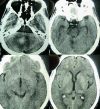Endoscopic management of hypertensive intraventricular haemorrhage with obstructive hydrocephalus
- PMID: 17204141
- PMCID: PMC1780056
- DOI: 10.1186/1471-2377-7-1
Endoscopic management of hypertensive intraventricular haemorrhage with obstructive hydrocephalus
Abstract
Background: Intracranial haemorrhage accounts for 30-60 % of all stroke admissions into a hospital, with hypertension being the main risk factor. Presence of intraventricular haematoma is considered a poor prognostic factor due to the resultant obstruction to CSF and the mass effect following the presence of blood resulting in raised intracranial pressure and hydrocephalus. We report the results following endoscopic decompression of obstructive hydrocephalus and evacuation of haematoma in patients with hypertensive intraventricular haemorrhage.
Methods: During a two year period, 25 patients diagnosed as having an intraventricular haemorrhage with obstructive hydrocephalus secondary to hypertension were included in this study. All patients underwent endoscopic evacuation of the haematoma under general anaesthesia. Post operative evaluation was done by CT scan and Glasgow outcome scale.
Results: Of the 25 patients, thalamic haemorrhage was observed in 12 (48%) patients, while, 11 (44%) had a putaminal haematoma. Nine (36%) patients had a GCS of 8 or less pre-operatively. Resolution of hydrocephalus following endoscopic evacuation was observed in 24 (96%) patients. No complications directly related to the surgical technique were encountered in our study. At six months follow-up, a mortality rate of 6.3% and 55.5% was observed in patients with a pre-operative GCS of > or = 9 and < or = 8 respectively. Thirteen of the 16 (81.3%) patients with a pre-operative GCS >/= 9 had good recovery.
Conclusion: Endoscopic technique offers encouraging results in relieving hydrocephalus in hypertensive intraventricular haemorrhage. Final outcome is better in patient with a pre-operative GCS of >9. Future improvements in instrumentation and surgical techniques, with careful case selection may help improve outcome in these patients.
Figures




Similar articles
-
Application of neuroendoscopy in the treatment of obstructive hydrocephalus secondary to hypertensive intraventricular hemorrhage.Neurol India. 2011 Nov-Dec;59(6):861-6. doi: 10.4103/0028-3886.91366. Neurol India. 2011. PMID: 22234200
-
Flexible Endoscopic Aspiration for Intraventricular Casting Hematoma.Acta Neurochir Suppl. 2016;123:17-23. doi: 10.1007/978-3-319-29887-0_3. Acta Neurochir Suppl. 2016. PMID: 27637624
-
Endoscopic surgery for thalamic hemorrhage: a technical note.Surg Neurol. 2007 Oct;68(4):438-42; discussion 442. doi: 10.1016/j.surneu.2006.11.054. Surg Neurol. 2007. PMID: 17905069
-
[Aneurysms with severe clinical manifestations (Hunt and Hess grade IV and V). A series of 66 cases].Neurochirurgie. 1990;36(5):287-96. Neurochirurgie. 1990. PMID: 2267042 Review. French.
-
Causes and treatment of intracranial haemorrhage complicating shunting for paediatric hydrocephalus.Childs Nerv Syst. 2000 Apr;16(4):218-21. doi: 10.1007/s003810050501. Childs Nerv Syst. 2000. PMID: 10855519 Review.
Cited by
-
Therapy management and outcome of acute hydrocephalus secondary to intraventricular hemorrhage in adults.Chin Neurosurg J. 2024 Jun 3;10(1):17. doi: 10.1186/s41016-024-00369-0. Chin Neurosurg J. 2024. PMID: 38831472 Free PMC article. Review.
-
Endoscopic Evacuation of Massive Intraventricular Hemorrhages Reduces Shunt Dependency: A Meta-Analysis.Asian J Neurosurg. 2022 Dec 5;17(4):541-546. doi: 10.1055/s-0042-1757220. eCollection 2022 Dec. Asian J Neurosurg. 2022. PMID: 36570748 Free PMC article. Review.
-
Prediction of Shunt-Dependent Hydrocephalus after Primary Supratentorial Intracerebral Hemorrhage with a Focus on the Influence of Craniectomies.J Korean Neurosurg Soc. 2022 Jul;65(4):582-590. doi: 10.3340/jkns.2021.0142. Epub 2022 Jun 30. J Korean Neurosurg Soc. 2022. PMID: 35765929 Free PMC article.
-
Hemorrhagic Stroke: Endoscopic Aspiration.Adv Tech Stand Neurosurg. 2022;44:97-119. doi: 10.1007/978-3-030-87649-4_5. Adv Tech Stand Neurosurg. 2022. PMID: 35107675
-
Advances in Therapeutic Approaches for Spontaneous Intracerebral Hemorrhage.Neurotherapeutics. 2020 Oct;17(4):1757-1767. doi: 10.1007/s13311-020-00902-w. Neurotherapeutics. 2020. PMID: 32720246 Free PMC article. Review.
References
-
- Sacco RL., Mayer SA . Epidemiology of intracerebral hemorrhage. In: Feldmann E, editor. Intracerebral hemorrhage. New York , Futura Publishing Co; 1994 . p. 3–23.
-
- Brott T, Thalinger K, Hertzberg V. Hypertension as a risk factor for spontaneous intracerebral hemorrhage. Stroke. 1986;17:1078–1083. - PubMed
-
- Thrift AG, McNeil JJ, Forbes A, Donnan GA. Risk factors for cerebral hemorrhage in the era of well-controlled hypertension. Melbourne Risk Factor Study (MERFS) Group. Stroke. 1996;27:2020–2025. - PubMed
-
- Thrift AG, Dewey HM, Macdonell RA, McNeil JJ, Donnan GA. Incidence of the major stroke subtypes: initial findings from the North East Melbourne stroke incidence study (NEMESIS) Stroke. 2001;32:1732–1738. - PubMed
Publication types
MeSH terms
LinkOut - more resources
Full Text Sources
Medical


